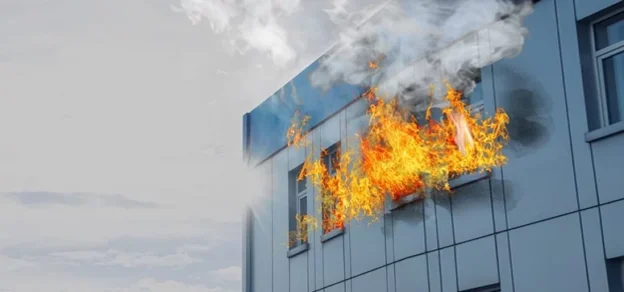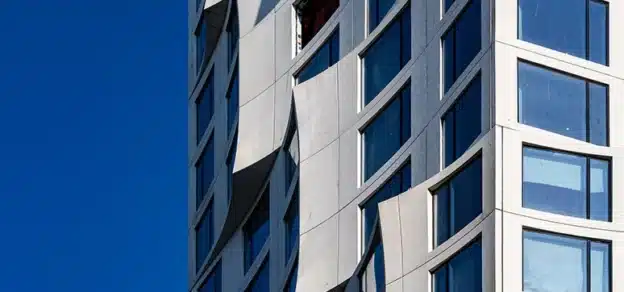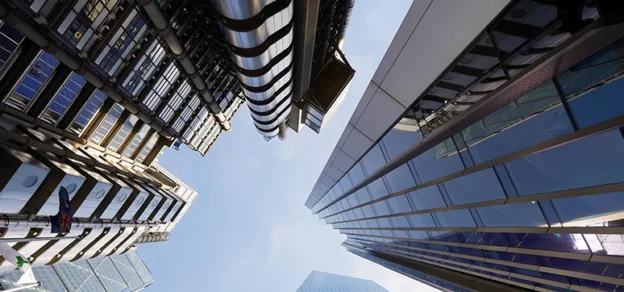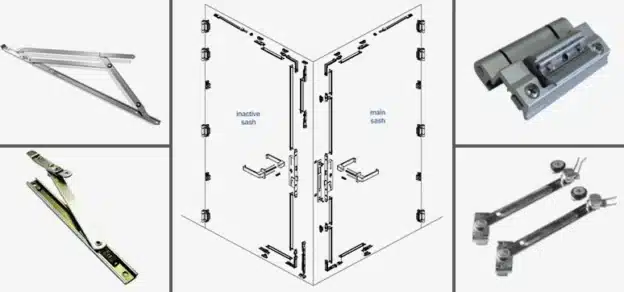As the 21st century is marked by rapid urbanisation, it is pertinent that the cities are growing vertically upwards with high-rises and skyscrapers marking the skyline of the city. The modern architecture for building envelope has evolved over the years, thus moving from minimalistic glass usage for building aesthetics to an enhanced aesthetic using a glass façade system keeping the performance of the overall building intact, thus giving a unique identity to the building. When the façade stands tall resisting its assets and occupants of the building against natural forces like heat, wind, seismic forces, drift, etc., the challenge lies in the right selection of the system which delivers enhanced building performance without compromising safety. In doing so, a major challenge awaits when the perimeter joint poses a threat to the rapid spread of fire and smoke in case of a fire incident.

Typically, a non-fire barriered perimeter joint between the edge of the slab and the exterior curtain wall easily facilitates the rapid spread of fire, smoke and other hot gases between adjacent floors through a most common “chimney effect” phenomenon. This traps the occupants and prevents effective firefighting, thus resulting in the loss of human lives and assets, most of which can be prevented with an appropriately designed fire barrier system.
So, while designing the fire safety of the building and to achieve a specific performance of the system like fire rating, smoke rating, movement, etc., we refer to the best practices across the globe which call for the relevant national and international codes and standards that guide on effective compartmentation to restrict the movement of fire and smoke. This calls for the design and right selection of products like the spandrel glass, vision glass, aluminium frames (transoms & mullions), spandrel and safing insulation, back pan, etc. for a complete façade system to comply with tested firestop system pre-requisite, which is expected to effectively perform during a fire incident.
CODES & STANDARDS
A plethora of codes and standards related to the fire safety of curtain wall systems help designers and consultants to choose the right one that suits their needs. In India, the NBC 2016 which is the accepted code of practice by all construction professionals recommends that for buildings featuring glass façade assembly, all gaps between floor slabs and façade assembly shall be sealed at all levels by approved fire-resistant sealant material of equal fire rating as that of the floor slab to prevent fire and smoke propagation from one floor to another. Though it doesn’t provide any specific standard test method for demonstrating the fire rating of the assembly, the standard test method as defined in ASTM E2307, a standard test method for determining the fire resistance of perimeter fire barriers using intermediate-scale, multistory apparatus satisfies the compliance requirements laid down in the code.
Furthermore, NFPA 101, 2018 clause 8.3.5.4.1 mentions that the voids created between the fire-resistance-rated floor assembly and the exterior curtain wall shall be protected with a perimeter joint system that is designed and tested in accordance with ASTM E2307 Test Standard.
TESTING AND RATINGS
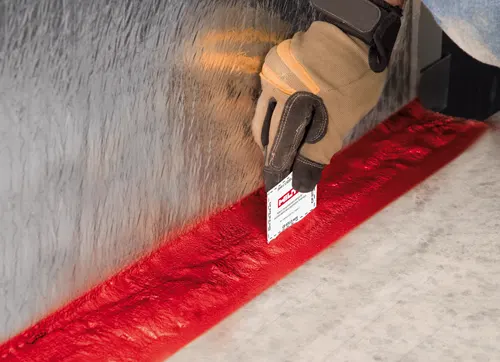
While an installed façade system is designed considering its exposure to live loads and environmental forces (wind, thermal and seismic), the dynamic perimeter fire barrier system should also be designed on similar lines to maintain a seal between the floor assembly and exterior curtain wall assembly having the ability to move in cyclic movement through expansion/contraction responding to environmental forces and resisting shear, fatigue and degradation while reacting to live loads. The cyclic rate, magnitude, and duration of movement can also affect the performance of the perimeter joint protection when subjected to fire exposure as defined in ASTM E119 and test conditions for the complete testing are provided in ASTM E2307.
In general, any void between the fire-rated floor and an exterior wall must be protected using a perimeter fire containment system that has been tested in accordance with ASTM E 2307 standard that provides an ‘F-rating’ that is equal to or greater than the fire-resistance rating of the floor. Furthermore, other ratings such as ‘T-Rating’ (Insulation), ‘L-Rating’ (Smoke/ Air leakage) and movement capability (%) are to be considered while designing the Perimeter Fire Barrier Joint System.
SYSTEM DESIGN OF TESTED SYSTEM
Third-party certification laboratory listing directories guide on right system selection for the perimeter firestop system. One of the examples is the Intertek certification directory. To choose the right system, it is important to know the basic details of the application such as the makeup of the exterior wall – spandrel glass, aluminum panel, etc., hourly rating, joint width, static or dynamic joint, etc.
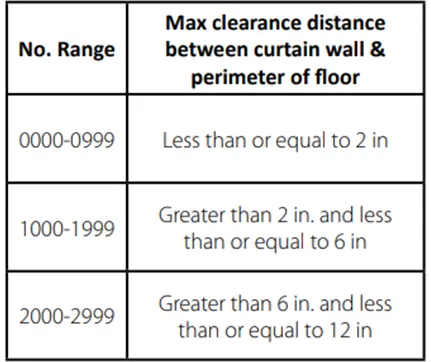
The Intertek directory follows a specific nomenclature system to identify the different firestop assemblies listed based on which right system can be chosen to suit the specific needs of the project.
- For e.g., when the system is numbered as ‘HI – BPF -120 -12’, it is to be read as • HI – Company identifier (Hilti in his case)
BPF – Barrier, Perimeter Fire - 120 – Rating of 120 min (F- Rating)
- 12 – 12th system tested in this grouping for the company.
UL certifications for perimeter joint system uses a unique nomenclature which is an alpha-alphanumeric identification system. The first two alpha characters, CW, identify the perimeter-fire containment system used at the interface of a fire-rated floor and a non-fire-rated exterior curtain wall.
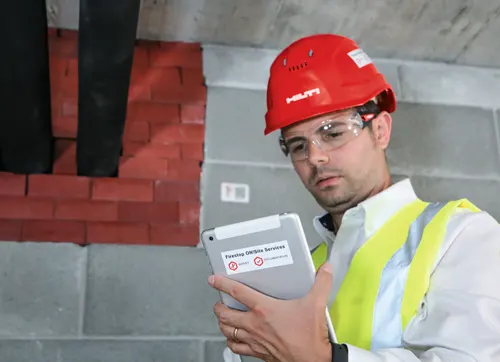
The third alpha character is either S or D where S signifies perimeter-fire containment systems that do not have movement capabilities (i.e., Static) and D signifies fire-containment systems that do have movement capabilities (i.e., Dynamic). The numeric component uses sequential numbers to identify the maximum clearance distance between the curtain wall and the perimeter of the floor and the significance of the number used is tabulated. During the time of firestopping at the site, unanticipated construction hindrances are often encountered which differ from the original design. And in such cases, the Engineering Judgments (EJ’s) are typically made that recommend alternative methods to ensure the performance of the firestop system is not compromised.
Since these recommendations are to be based upon identical designs as those which were fire tested, it is important that they be developed using sound engineering principles and must be provided by trained and qualified personnel based on the recommendations prescribed in IFC guidelines.
INSTALLATION, INSPECTION & DOCUMENTATION
The effectiveness and performance of a firestop system largely depend on the installation. Since the perimeter fire barrier system is a ‘Listed’ system, it must be installed in accordance with its listing and the manufacturer’s installation instructions. Typically, firestop manufacturers will have their own programs and qualification criteria to train and educate specialty firestop installers.

The following points help to inspect and ensure the effective functioning of the perimeter Fire barrier system.
• Is the rating of the perimeter fire barrier system equal to or greater than the floor it is adjacent to?
• Is the EOS joint system tested and listed by an accredited lab?
• Is the installation done by a trained and qualified installer?
• Is EJ made available (based on IFC guidelines) in case of non-availability of the tested system exactly matching the actual site condition?
• Are the details of the installed system documented in an appropriate manner to enable the Inspections and maintenance of the firestop system?
PERFORMANCE OF TESTED PER BARRIER FIRE BARRIER JOINT SYSTEM IN REAL FIRE SCENARIO
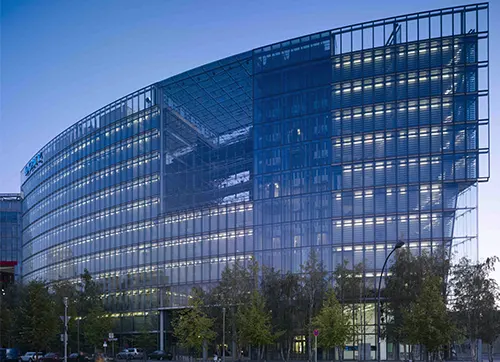
It is worth noting that the series of experiments conducted at IIT-GN over the past few years on the performance of the Perimeter Fire Barrier Joint system in real fire scenarios provides a testament to the fact that the ‘Tested Fire barrier joint System’ outperforms the ‘non-tested traditional Fire barrier joint system’ in terms of resistance to the propagation of Fire and smoke from one floor to the other. Apart from resisting the propagation of fire, the movement-tested system ensures that it can accommodate the deflection arising in the structure due to heat generated due to fire. Furthermore, it ensures that the smoke is not propagated beyond acceptable limits from one floor to the other thus ensuring life safety and asset protection.
CONCLUSION
The use of tested and listed perimeter firestop system is required by the ‘Building and Life Safety Codes’ to contain the fire and smoke in place of its origin and the absence of such a system in buildings may turn a simple fire incident into a catastrophic inferno. It is important to have the ‘Fire Barrier System’s appropriately designed, installed, inspected and maintained (documented) for serving its intended use. Adherence to code requirements enables to save lives and protect assets and ensures peace of mind for the builders, contractors, architects, inspectors and most importantly the building occupants.





